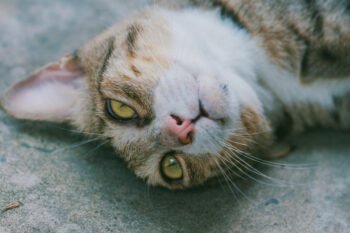Does your cat sport the feline equivalent of love handles? That extra cushioning might look cute, but it places your cat at risk for feline diabetes. Cases of this disease are soaring, to the point where some veterinarians consider diabetes in cats to be an epidemic. Last year a study at Edinburgh University in England found that of the estimated 90 million cats in the U.S., almost 400,000 will develop diabetes at some point in their lives.
Just what’s going on with our pets? Veterinarians say the trend mirrors the rise in diabetes among humans, and feline diabetes has similar causes. Weight gain and a sedentary lifestyle are contributing culprits for both humans and cats. Similarly, a healthy diet and regular exercise work as preventative measures for our cats, just as they do for us.
Is your kitty among those cats at risk? Educating yourself about feline diabetes can go a long way toward protecting your cat’s health. Here are four important steps you may follow:
Recognize the Symptoms
Just like their human counterparts, diabetic cats either don’t produce enough insulin or they develop sensitivity to the insulin in their bodies. This results in high glucose, or sugar, levels in the blood. This, in turn, can cause serious long-term health problems in your cat. The warning signs of feline diabetes are quite similar to the symptoms humans experience with Type II diabetes. Dr. Karen Becnel, who operates a cats-only clinic in a New Orleans suburb, says you’ll want to have your cat examined by a veterinarian if you notice any of the following:
- Increased thirst
- Increased urination
- Weight loss
- Increased appetite
- A disheveled appearance (A cat might not groom itself properly.)
- Poor muscle tone
Recognizing the factors that can lead to feline diabetes is as critical as recognizing the disease’s symptoms.
Understand the Causes
There’s certainly more to love when it comes to the cats visiting Dr. Elizabeth Colleran’s Chico, Calif., cat hospital. Increasingly, the cats she sees could afford to shed a pound — or three.
Although there has been some discussion over the feeding of wet versus dry food when it comes to feline diabetes, a University of Missouri study last year found the type of food made no difference. The single biggest determining factor was the cat’s weight — and a whopping 40 percent of our cats are overweight.
Other factors include inactivity, longevity and perhaps genetics. Due to the latter, for example, Burmese cats are likely more at risk for developing the disease. If you have such an at-risk cat, discussions about diabetes with your veterinarian are even more critical.
Work to Prevent Diabetes
Dr. Colleran teaches cat owners how to play with their furry friends. It’s all part of educating them about their cat’s need for activity. Colleran and other veterinarians recommend that you should do these things to help keep your cat healthy:
- Schedule regular checkups with blood tests.
- Practice portion control. Free-feeding is a no-no, says Dr. Elaine Wexler-Mitchell, who frequently sees diabetic cats in her Orange, Calif., feline clinic.
- Discuss your cat’s nutritional needs with your veterinarian and carefully measure out food.
- Play more. “We unfortunately have a generation of couch potato kitties that have all the benefits of indoor living, but they are being overfed and under-exercised,” Dr. Becnel says.
Cats live longer when they’re kept indoors, but you need to make sure your cat gets up and moving. If your cat is diagnosed with diabetes, you’ll take an active role in maintaining its health.
Treating Feline Diabetes
“Feline diabetes is manageable, through diet and medication. Some veterinarians recommend steering clear of high-carbohydrate foods. Not exceeding your cat’s caloric needs is important”, says Colleran. For example, an average adult cat should daily receive about 3 ounces of cat food per 3 1/2 pounds of body weight, but check with your veterinarian to see what amounts would be best for your cat. We recommend these high-quality diabetic cat foods that are specifically designed for diabetes if your cat is suffering.
You’ll most likely need to inject your cat with insulin. Don’t worry; it’s not as hard as it might seem. “Almost everyone cringes at the idea they’re going to give their cat a shot,” says Becnel, “but 99.9 percent are able to give their cats shots successfully.”
Ask your veterinarian to demonstrate several times how to give an injection. Becnel shaves a small area on a cat so that the owner can easily see where to inject the needle, and cat owners practice under her watchful eyes.
The Long-Term Outlook
“Although cats that have diabetes are more prone to kidney problems, urinary tract infections and other health-related issues, many can expect to live normal lives. A new type of insulin, glargine, has been particularly effective,” say Becnel and Colleran. They’re actually seeing some reversals in newly diagnosed cats after treating with glargine and working to control the cats’ diets.
Owners who are well-educated on the indicators of diabetes often bring their cats to the veterinarian at the first warning signs. This has helped significantly in the management of the feline diabetes epidemic. “If we can control the blood sugar and get the cat’s weight under control, the prognosis is excellent,” says Becnel. “The large majority now lives for many years.”
If your cat is suffering from diabetes, read our diabetic cat resources which address all aspects of taking care of your diabetic cat. We also offer our breakdown of the best diabetic cat foods, which includes what to look for based on your cat’s specific needs, so both you and they can have an easier life.







